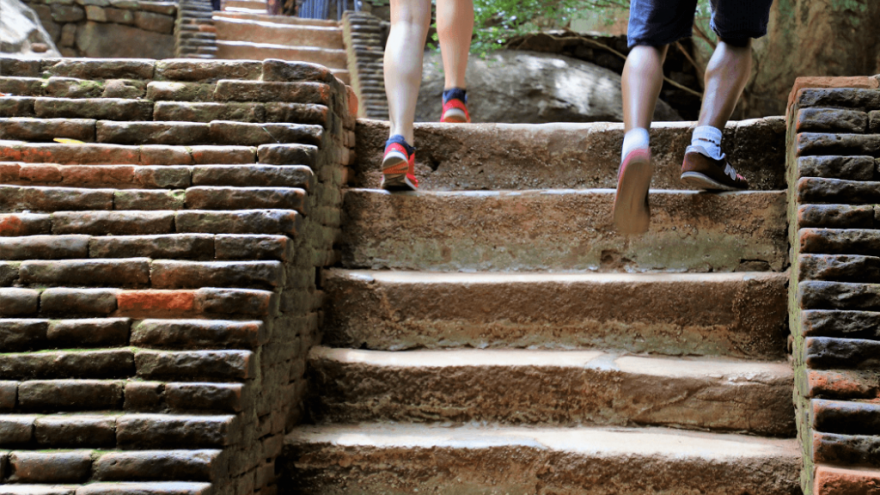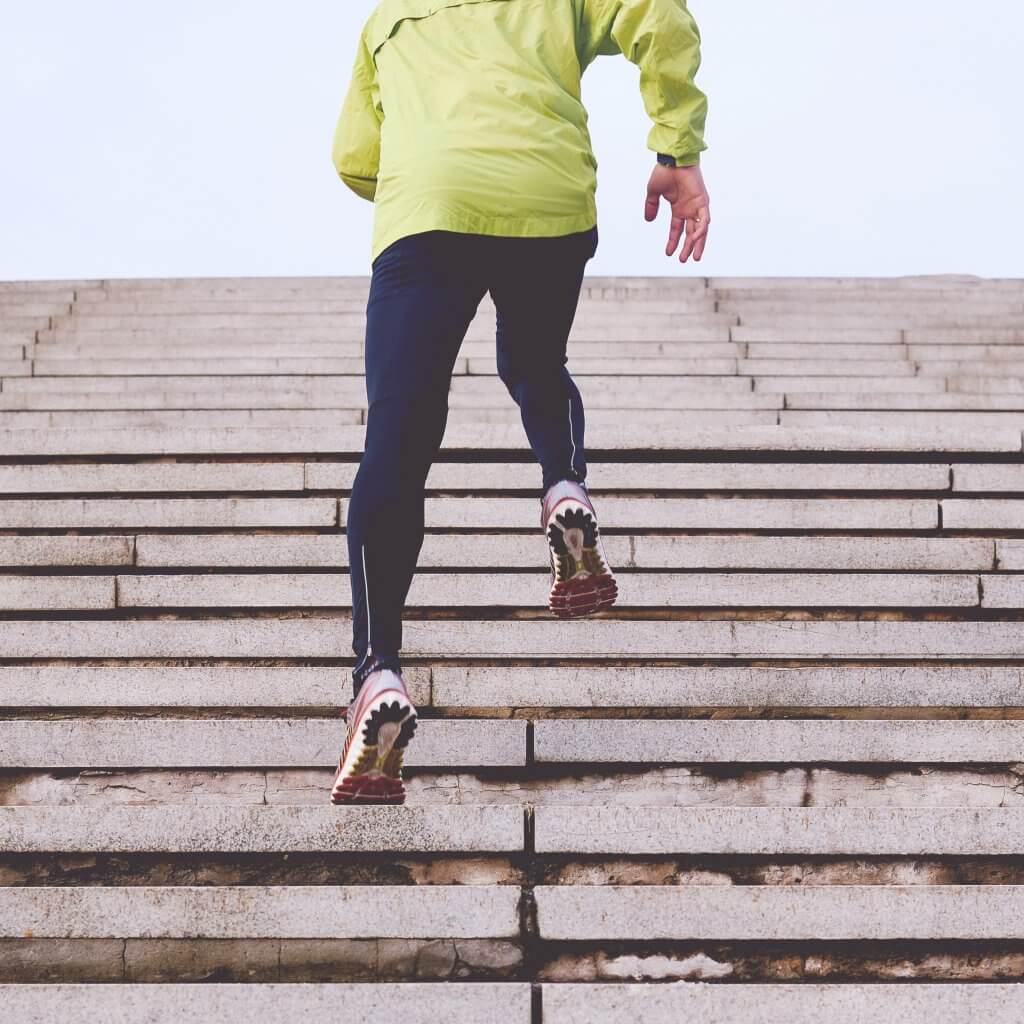Injured? Try the StairMaster!

If you are one of the few lucky runners who has never once suffered from a running-related injury, then consider yourself EXTREMELY lucky! Running can be a very intense sport. Runners are known for being Type A people, usually, and they often push themselves to run even when they probably shouldn’t. And a lot of the time, the result is a nasty injury in which we have to take several days, weeks, and even months off from running to let our bodies heal.
But what if we have a big race coming up that we have really been looking forward to and we do not want to let an injury sideline us from at least keeping up our fitness levels? Or what if we just want to stay active and keep moving, even with an injury? Sure, we can take to the gym floor and focus more on weighted upper body exercises, but we are runners! We crave the “runner’s high” and the surge of endorphins from cardio exercises. Fortunately, not all hope is lost. If your injury is stopping you from running, but your doctor has okay’d you to still walk on it or put weight on it, then you should try your hand at the StairMaster.

It Helps Maintain Your Running Endurance
The StairMaster has a bit of a notorious rep for a reason – it is hard! Crank up the speed level and you will very soon understand why it is known for really making users break a sweat, huff, and pant, and why it is often a component of High-Intensity Interval Training (HIIT) workouts. Like running, doing the StairMaster at a lower speed (similar to jogging) puts the body in an aerobic phase. This is known as the fat burning phase because fat is the body’s first choice of fuel and energy for these types of workouts. This level is slower and steadier and can be held consistently for a longer period of time so you can maintain it for longer. It is a great option for keeping up your endurance if you have a long distance running race coming up and do not want to lose the stamina you have built up. But there is also the option to turn up the volume and get that heart rate up. Now, if you have a running injury which your doctor has advised you NOT to run, then you will want to avoid this high level StairMaster workout, because turning up the speed will mean turning up your own speed levels, so that you are more running up the stairs, as opposed to simply slowly climbing.
But if you are a runner who is either
1) injured but can still run a little bit or
2) just looking for alternative exercises to incorporate into your workout routine that mimics the strength training and performance of running but switches up things enough to give you something new and exciting to do, then this style of cardio is an excellent option.
It puts the body into an anaerobic phase, meaning oxygen is not readily available and the body has to work much harder (aka burn more calories at a faster rate) to keep up. Anaerobic exercises, because they are without oxygen, can’t be sustained for very long, and the body’s first choice of fuel for these types of workouts are carbohydrates. Again, this is a great option to incorporate into your typical training (once your injuries have healed) because it helps mimic the end-of-the-race “kick” that you often need to sprint it out. That kind of increased running pace, especially after just having burned through so many fat calories, puts the body in an aerobic state. You have to be in excellent shape to have a successful “kick,” and the StairMaster can help get you there.

It Helps Build Strength
If you have ever been to a building with a long staircase that you have had to climb on foot, you know that it is not always the easiest physical task. Climbing stairs really engage your quadriceps, glutes, and calves (if you tend to put your weight more forward on your toes). While you also engage these muscles when you run, the amount to which they are engaged and working on the StairMaster is a bit different because you are holding your body at a different angle than when you run, and because the motion of stepping up is different than when you are striding out during a run. And the result might mean you wake up the next morning after an intense StairMaster session to some sore muscles.
But just like any other type of exercise, repeatedly taking to the StairMaster for your workouts will lead to building strength and toning those muscles. Not only will you develop a more toned lower body and physique, but the strength that you have gained will really help you become a better, stronger runner. This is a great way to ensure you do not lose physical fitness when you are taking a break from running and want to be sure that when you decide it is time to come back to it, you will not have to work as hard to get yourself back to the level of “running shape” that you were in before you got injured or just decided to take some time off.

It Fights Boredom
Getting on the StairMaster can be fun! While you might think it pales in comparison to being able to get outside and run through nature, you can easily change up the speed on a StairMaster and really break a sweat while enjoying yourself. If you are worried that your running injury has got you stuck monotonously whirling around on an elliptical machine that never changes resistance levels, or on the rowing machine that hardly targets your lower body at all to help maintain your fitness levels, or even on the stationary bike which can bring on a whole new level of boredom, fear not! The StairMaster can be as fast or as slow, as hard or as easy as you want it to be that day.
And unlike other cardio exercises, you can get really creative. For instance, you can choose to do the StairMaster by facing to the left or right and sidestepping or even slow up the speed and face backward to really target those glutes. Plus, if you want to combine cardio and strength training, the StairMaster makes it easy. You can slow down the speed and grab a pair of dumbbells or hand weights to work your biceps, triceps, and shoulders even while you trekking up the stairs.
Happy climbing!
Latest Articles
 Is Running on a Treadmill Easier Than Running Outside?Runners have their own preferences, whether it is treadmill running, running outside on the road, or exploring trails. So...
Is Running on a Treadmill Easier Than Running Outside?Runners have their own preferences, whether it is treadmill running, running outside on the road, or exploring trails. So... Is It OK to Use Trail Running Shoes on the Road?While trail running shoes can be used on roads, especially in situations where a runner encounters mixed terrains or pref...
Is It OK to Use Trail Running Shoes on the Road?While trail running shoes can be used on roads, especially in situations where a runner encounters mixed terrains or pref... How to Fix Sore Quads After Running?Rest, ice, gentle stretching, and over-the-counter pain relievers can help soothe sore quads after running. Also, ensure ...
How to Fix Sore Quads After Running?Rest, ice, gentle stretching, and over-the-counter pain relievers can help soothe sore quads after running. Also, ensure ... 10 Fruits With The Most Electrolytes to Replace Sports DrinksThese fruits are high in electrolytes such as potassium, magnesium, and calcium, essential for hydration, muscle function...
10 Fruits With The Most Electrolytes to Replace Sports DrinksThese fruits are high in electrolytes such as potassium, magnesium, and calcium, essential for hydration, muscle function...

